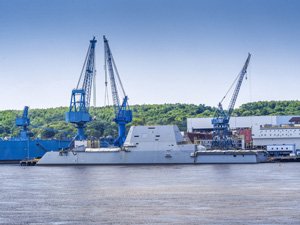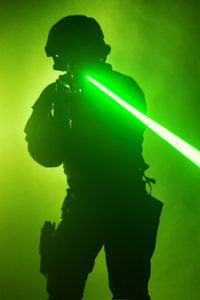Defense stocks are one of the smartest buys of the Trump era, given his stated commitment to boosting defense spending by $54 billion.
As we’ve seen, drones and autonomous vehicles are two high-profit ways to play the growth energizing this $1.7 trillion sector…
[ad#Google Adsense 336×280-IA]But the big play – the really disruptive, transformative 21st-century technology – is military lasers.
“Ray guns.”
It sounds like science fiction, but it’s a fact. Laser weapons are here now, and perhaps as soon as next year they’ll change the way the U.S. military fights conflicts all over the world.
You’ll have reaped the financial rewards long before that, though…
An Infinite, Safe Supply of Ammunition
You can’t fight without ammo, and that makes it a huge consideration to weigh when you’re designing (and paying for) a fighter plane or a battleship, for example.
A turret for a 16-inch naval gun housing costs around $1.5 million – without the guns. Shells can weigh anywhere from 1 to 1.5 tons, and each one going to outfit the U.S. Navy’s new, $4 billion Zumwalt-class destroyer costs $800,000.
 Ammo can be dangerous, too.
Ammo can be dangerous, too.
Shells need to be stored in huge, vulnerable magazines aboard ships. In battle, a lucky shot at a ship’s magazine might cause a catastrophic explosion.
Even in peacetime, lethal misfires and explosions have occurred, killing dozens of sailors.
The technology is, essentially, medieval.
Of course there have been refinements over the centuries, but at the end of the day, a shell is a heavy piece of metal hurled downrange though a sturdy tube by exploding chemical propellants, just like it was in the 13th century.
Laser weapons could make all this ancient history.
You don’t need to keep expensive, dangerous shells around anymore, and you don’t have to build your planes and ships to accommodate them, either, so your weapons platform – manned or unmanned – is open to other useful equipment.
They’re precise, too. Explosions are messy, and no matter how carefully explosive shells and missiles are aimed, innocent people can and do get hurt or killed. That’s not a concern with a laser, which will hit its target and nothing else, every time.
The idea of laser weapons has, of course, been around for a long time, but the great challenge in weaponizing them – electrical power, and lots of it – has only recently been overcome.
One of my long-time favorite defense companies was the first to unveil a laser weapon in 2014. Kratos Defense & Security Solutions Inc. (Nasdaq: KTOS) strapped together six commercial welding lasers and built the first operational laser weapon for the U.S. Navy.
Kratos’ Laser Weapons System (LaWS) was about 30 kilowatts (kw) and could down a drone and poke a hole in a ship at 1,000 meters.
It was an impressive proof of concept that attracted attention from some of the biggest players in defense.
Lockheed Martin Corp. (NYSE: LMT) did Kratos one better: It built a 60-kw laser that mounts on the back of truck and that can take out a drone at 500 meters.
These breakthroughs have ignited a kind of domestic “laser arms race,” with contractors pouring into the laser niche.
The company I’m about to show you isn’t the biggest or the flashiest, but it has exactly what it takes to grow into a dominant position in laser weaponry.
This Is the Best Laser Weapons Play on the Market
It was already one of my favorite defense and aerospace plays, too, before it moved into lasers. These shares are up 17% in the past 12 months, revenue is up 6% year on year, and earnings per share were up 20% at this company’s last report.
The board will pay you a tidy $1.00 a share to own it, too, up from $0.90 last quarter.
This player is none other than Northrop Grumman Corp. (NYSE: NOC).
Northrop Grumman has been a pioneer in the aerospace sector since the early days. Its savvy mergers and acquisitions over the years have made the firm highly respected for its weapons systems and sensors, as well.
Northrop’s current flagship product is the B-2 “Spirit” stealth bomber, and it’s been awarded the second-biggest defense contract in history to product the “next generation” B-21 bomber.
But the company has bought some of the biggest names in electronic engineering over the years, too: Westinghouse Electric Corp., Litton Industries, and Trans World Radio, just to name a few. This accumulated “know-how” is absolutely critical to the development of laser weapons.
That’s why Northrop is in the perfect spot to usher in the “Laser Age.”
 The U.S. Navy has picked Northrop to take laser weapons to the next level. The Navy is the natural choice among the armed services to lead the development and adoption of lasers.
The U.S. Navy has picked Northrop to take laser weapons to the next level. The Navy is the natural choice among the armed services to lead the development and adoption of lasers.
I mentioned the key challenge with laser weapons is in the electrical power they demand. The Navy’s big ships have the space aboard to house the large generators needed to power truly lethal lasers, although inevitable miniaturization means air- and land-based weapons will arrive eventually.
Northrop is building the Laser Weapon System Demonstrator (LWSD) that, at 150 kw, will be 4.5 times more powerful than the LaWS and cost just $2 per shot. Remember, the shells on the new U.S.S. Zumwalt cost around $800,000 apiece.
Those cost savings are going to play a huge role on the political side of this project.
The “Trump Factor” Isn’t a Worry Here
Donald Trump has, of course, been quite outspoken on his desire to ramp up military spending to around $600 billion overall.
At the same time, he’s been openly, even harshly critical of projects he deems too “expensive” or “complicated,” like Air Force One upgrades, or the F-35 “Lightning” Joint Strike Fighter. This has introduced an element of uncertainty for defense investors, but one that’s likely to abate as Trump steps back and Congress and the Pentagon take over the execution of his directive to “make America’s military great.”
Besides, as high-tech as lasers are, they’re not really all that complicated, and as I said, they’re much cheaper than conventional weapons. Retrofitting naval vessels with the generators needed to power them is fairly easy.
What’s more, there’s a rich pool of research and development funding, which has jumped $6 billion to sit at $83 billion.
And that works especially well for Northrop Grumman, and it’s going to pay especially well for Northrop shareholders.
There’s no telling how far this contractor will advance the field of laser weaponry. The Air Force, for instance, says it wants a 300-kw laser weapon deployed on its fleet of AC-130 “Spooky” gunships by 2022.
Northrop will be there to deliver the goods.
— Michael A. Robinson
[ad#mmpress]
Source: Money Morning
